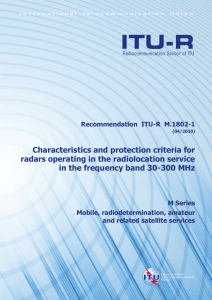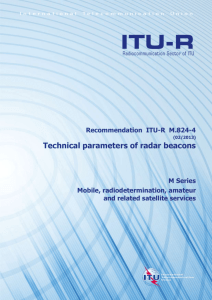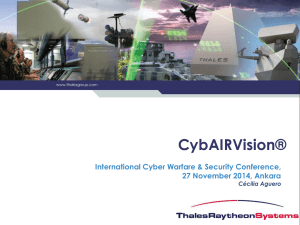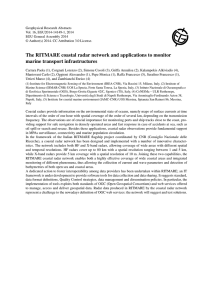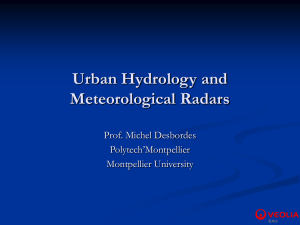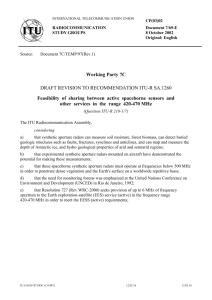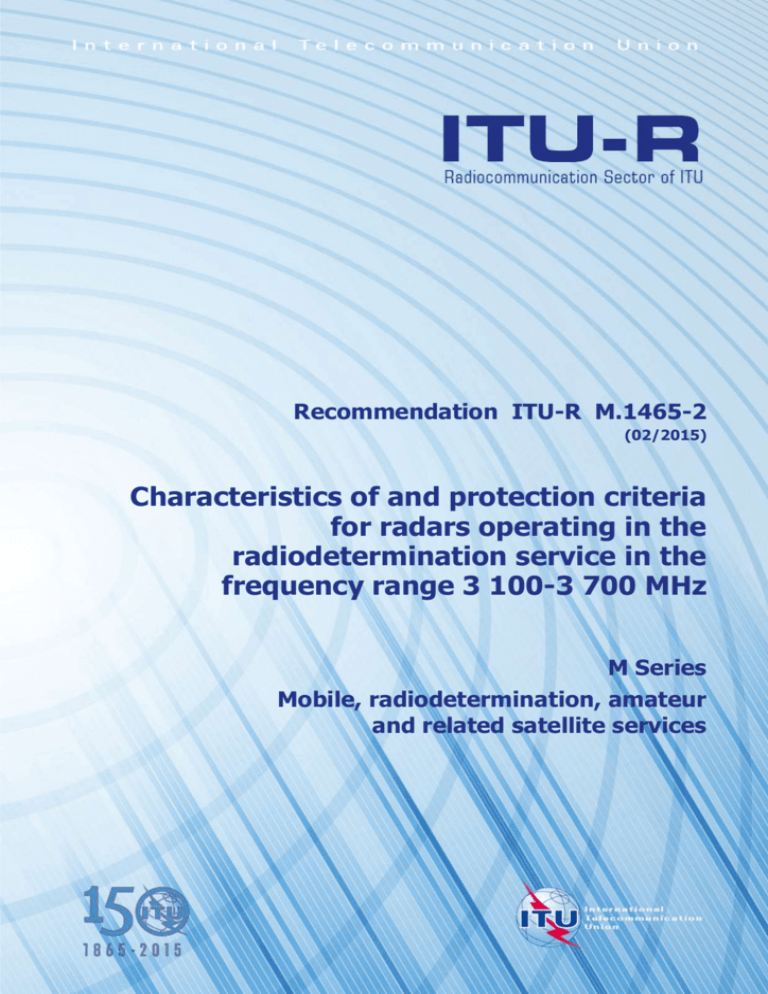
Recommendation ITU-R M.1465-2
(02/2015)
Characteristics of and protection criteria
for radars operating in the
radiodetermination service in the
frequency range 3 100-3 700 MHz
M Series
Mobile, radiodetermination, amateur
and related satellite services
ii
Rec. ITU-R M.1465-2
Foreword
The role of the Radiocommunication Sector is to ensure the rational, equitable, efficient and economical use of the
radio-frequency spectrum by all radiocommunication services, including satellite services, and carry out studies without
limit of frequency range on the basis of which Recommendations are adopted.
The regulatory and policy functions of the Radiocommunication Sector are performed by World and Regional
Radiocommunication Conferences and Radiocommunication Assemblies supported by Study Groups.
Policy on Intellectual Property Right (IPR)
ITU-R policy on IPR is described in the Common Patent Policy for ITU-T/ITU-R/ISO/IEC referenced in Annex 1 of
Resolution ITU-R 1. Forms to be used for the submission of patent statements and licensing declarations by patent
holders are available from http://www.itu.int/ITU-R/go/patents/en where the Guidelines for Implementation of the
Common Patent Policy for ITU-T/ITU-R/ISO/IEC and the ITU-R patent information database can also be found.
Series of ITU-R Recommendations
(Also available online at http://www.itu.int/publ/R-REC/en)
Series
BO
BR
BS
BT
F
M
P
RA
RS
S
SA
SF
SM
SNG
TF
V
Title
Satellite delivery
Recording for production, archival and play-out; film for television
Broadcasting service (sound)
Broadcasting service (television)
Fixed service
Mobile, radiodetermination, amateur and related satellite services
Radiowave propagation
Radio astronomy
Remote sensing systems
Fixed-satellite service
Space applications and meteorology
Frequency sharing and coordination between fixed-satellite and fixed service systems
Spectrum management
Satellite news gathering
Time signals and frequency standards emissions
Vocabulary and related subjects
Note: This ITU-R Recommendation was approved in English under the procedure detailed in Resolution ITU-R 1.
Electronic Publication
Geneva, 2015
ITU 2015
All rights reserved. No part of this publication may be reproduced, by any means whatsoever, without written permission of ITU.
Rec. ITU-R M.1465-2
1
RECOMMENDATION ITU-R M.1465-2
Characteristics of and protection criteria for radars operating in the
radiodetermination service in the frequency range 3 100-3 700 MHz
(2000-2007-2015)
Scope
This Recommendation provides technical and operational characteristics, as well as protection criteria, of
operational land/ship/air based radars in the frequency range 3 100-3 700 MHz. The Recommendation
includes representative characteristics on the transmitter, receiver, and antenna components, as well as
deployment information, of these radars.
Keywords
Characteristics, protection criteria, ship radar, ground-based radar, airborne radar
Abbreviations/Glossary
AMSL
Above mean sea level
ATC
Air traffic control
MTI
Moving target indication
PPI
Planned position indicator
The ITU Radiocommunication Assembly,
considering
a)
that antenna, signal propagation, target detection, and large necessary bandwidth
characteristics of radar to achieve their functions are optimum in certain frequency bands;
b)
that the technical characteristics of radars operating in the radiodetermination service are
determined by the mission of the system and vary widely even within a frequency band;
c)
that the radionavigation service is a safety service as specified by No. 4.10 of the Radio
Regulations (RR) and harmful interference to it cannot be accepted;
d)
that considerable radiolocation and radionavigation spectrum allocations (amounting to
about 1 GHz) have been removed or downgraded since WARC-79;
e)
that some Radiocommunication Study Groups are considering the potential for the
introduction of new types of systems (e.g., fixed wireless access and high density fixed and mobile
systems) or services in frequency bands between 420 MHz and 34 GHz used by radars in the
radiodetermination service;
f)
that representative technical and operational characteristics of systems operating in
frequency bands allocated to the radiodetermination service are required to determine the feasibility
of introducing new types of systems;
g)
that procedures and methodologies are needed to analyse compatibility between radars
operating in the radiodetermination service and systems in other services;
h)
that the frequency band 3 100-3 400 MHz is allocated to the radiolocation service on a
primary basis in all three Regions;
2
Rec. ITU-R M.1465-2
i)
that the frequency band 3 400-3 600 MHz is allocated to the radiolocation service on a
secondary basis in Region 1;
j)
that the frequency band 3 400-3 600 MHz is allocated to the radiolocation service on a
primary basis in Regions 2 and 3;
k)
that the frequency band 3 600-3 700 MHz is allocated to the radiolocation service on a
secondary basis in Regions 2 and 3;
l)
that the frequency band 3 100-3 300 MHz is also allocated to the radionavigation service on
a primary basis in the countries listed in No. 5.428 of the RR,
recognizing
a)
that No. 5.433 of the RR states that in Regions 2 and 3, in the frequency band
3 400-3 600 MHz the radiolocation service is allocated on a primary basis. However,
all administrations operating radiolocation systems in this frequency band are urged to cease
operations by 1985. Thereafter, administrations shall take all practicable steps to protect the
fixed-satellite service and coordination requirements shall not be imposed on the fixed-satellite
service,
recommends
1
that the technical and operational characteristics of the radiolocation radars described
in Annex 1 should be considered representative of those operating in the frequency range
3 100-3 700 MHz;
2
that Recommendation ITU-R M.1461 should be used as a guideline in analysing
compatibility between radars operating in the radiodetermination service with systems in other
services;
3
that the criterion of interfering signal power to radar receiver noise power level, I/N, of –6
dB should be used as the required protection level for the radiolocation systems, and that this
represents the net protection level if multiple interferers are present.
Annex 1
Technical and operational characteristics of radiolocation radars
operating in the frequency range 3 100-3 700 MHz
1
Introduction
The characteristics of radiolocation radars operating in the frequency range 3 100-3 700 MHz are
presented in Table 1, and are discussed further in the following paragraphs.
Rec. ITU-R M.1465-2
3
TABLE 1
Table of characteristics of radiolocation systems in the frequency range 3 100-3 700 MHz
Land-based systems
Parameter
Airborne
system
Ship systems
Units
Use
Modulation
A
B
Surface
and air
search
Surface
search
P0N/Q3N
P0N
B
C
D
Surface and air search
P0N
Q7N
P0N/Q7N
3.5-3.7
3.1-3.5
3.1-3.5
A
Surface and air
search
Q7N
Q7N
Tuning range
GHz
Tx power into
antenna (Peak)
kW
640
1 000
1 000
4 000-6 400
60-200
4-90
1 000
Pulse width
s
160-1 000
1.0-15
0.25, 0.6
6.4-51.2
0.1-1000
0.1-100
1.25(1)
kHz
0.020-2
0.536
1.125
0.152-6.0
0.3-10
0.5-10
2
48 000
Not
applicable
Not
applicable
64-512
Up to 20 000
Up to 400
250
Not
available
Not
applicable
Not
applicable
CPFSK
Not available
Not available
Not available
%
2-32
0.005-0.8
0.28, 0.67
0.8-2.0
Max 20
Max 20
5
Tx bandwidth
(–3 dB)
MHz
25/300
2
4, 16.6
4
25
3,15
> 30
Antenna gain
dBi
39
40
32
42
Up to 40
Up to 40
40
Parabolic
PA
1.7, 1.7
Repetition rate
Compression ratio
Type of compression
Duty cycle
3.1-3.7
A
Antenna type
Beamwidth (H,V)
Parabolic
degrees
Vertical scan type
Maximum vertical
degrees
1.72
1.05, 2.2
1.75, 4.4,
csc2 to 30
Not
available
Not
applicable
Not
applicable
93.5
Not
Not
3.1-3.7
-SWA
1.1-5,1.1-5
1.5-6, 4-20
Random
Not
applicable
Not
applicable
Not available
90
60
1.2, 6.0
4
Rec. ITU-R M.1465-2
Land-based systems
Parameter
Units
A
scan
Vertical scan rate
degrees/s
Horizontal scan type
Maximum horizontal
scan
Horizontal scan rate
Airborne
system
Ship systems
A
applicable
applicable
15
Not
applicable
Not
applicable
Rotating
degrees
degrees/s
B
B
Not applicable
Rotating
360
Random
C
D
Instantaneous
Continuous
360 + Sector
360
A
Not available
Continuous
360 + Sector
Rotating
360
360
15
25.7
24
Not
applicable
30-360
50-180
36
RHCP
V
H
V
Not available
V
Not available
dBm
Not
available
–112
–112
Not
available
Not available
Not available
Not available
S/N criteria
dB
Not
applicable
0
14
Not
available
Not available
Not available
Not available
Rx noise figure
dB
3.1
4.0
4.8
5.0
1.5
1.5
3
Rx RF bandwidth (–3
dB)
MHz
Not
available
2.0
Rx IF bandwidth
(–3 dB)
MHz
380
0.67
8
10
10-30
2-20
1
Worldwid
e
Worldwide
Worldwide
Worldwide
Worldwide
Worldwide
Worldwide
Polarization
Rx sensitivity
Deployment area
(1)
100 ns compressed.
CPFSK: Continuous-phase FSK
PA:
Phased array
SWA:
Slotted waveguide array
Not available
400
Not available
Rec. ITU-R M.1465-2
2
5
Technical characteristics
The frequency range 3 100-3 700 MHz is used by radars with installations on land, on ships and on
aircraft. In general, the predominant use by mobile radars is on ships and aircraft while the fixed,
land-based systems are operated at test ranges and are often deployed aboard tethered balloons for
surveillance over land or coastal areas. Functions performed include search for near-surface and
high altitude airborne objects, sea surveillance, tracking of airborne objects, and for multi-purpose
test range instrumentation. Both unmodulated and angle modulated pulse modulation is employed
and the typical peak transmitter power ranges from 500 kW to 6 400 kW. Low duty cycles are
employed for search radar functions with typical values ranging less than 1%. Receiver noise
figures typically range from 3.1 dB to 16 dB. Table 1 contains representative characteristics for two
land-based radar systems, two ship systems and one airborne system operating in the frequency
range 3 100-3 700 MHz.
2.1
Land-based radars
2.1.1
Land-based radar operations
Land-based radars operating in the frequency range 3 100-3 700 MHz are employed usually for test
operations on and off test ranges. Many of these radars are mobile in the sense that they are often
mounted on wheeled vehicles to relocate the radar to provide search and tracking functions for
airborne vehicles along extended flight paths. Others are installed in fixed locations at test ranges
where they also provide both search and tracking functions.
Land-based System B, in Table 1, is tethered at up to 4 600 m altitude to provide extended range
surveillance of up to 275 km. Land-based system A depicted in Table 1 operates mainly during
daylight hours in good flying weather with occasional night operations while the tethered balloon
borne radars operate continuously.
2.1.2
Transmitter
Transmitters are tunable and are subject to operating anywhere within the frequency range
3 100-3 700 MHz. Unmodulated pulse, single-channel angle modulated and multichannel
angle-modulated modulations are employed.
2.1.3
Receiver
Many of the test range radar receivers have special gating circuits for correlation of video data and
data feed to various displays, operator consoles and recording devices. The video data received by
the tethered balloon radar is relayed to ground operator facilities by both radio (fixed service)
and wire.
2.1.4
Antenna
Antennas are designed for their special purpose on the test range but operate with main beam gain
up to 40 dBi, are electronically steered and are usually directed skyward in random directions
increasing the possibility of illuminating space borne objects and receiving energy from them.
The tethered balloon radars direct their antennas at the horizon to a few degrees above it.
6
Rec. ITU-R M.1465-2
2.2
Shipborne radar
2.2.1
Ship-based operations
Four representative types of shipboard radars operating in the frequency range 3.1-3.7 GHz are
depicted in Table 1 as System A through D. System A is used as a primary aircraft carrier air traffic
control system. System B is multifunction radar deployed aboard escort ships. Operational areas of
these shipboard radars include littoral and high seas. These radars are typically operated on a roundthe-clock schedule. When providing escort for other ships, it is not uncommon to find up to ten of
these radars operating simultaneously. In addition to the shipboard systems there are fixed systems
on land that are used for training and testing. Also, routine maintenance and testing operations
require that these radars be operated occasionally in certain port areas. A System A equipped ship is
almost always accompanied by at least one System B equipped ship.
2.2.2
Transmitter
System A transmits in the frequency band 3 500-3 700 MHz with a peak power of 1 000 kW.
System B transmits in the frequency range 3 100-3 500 MHz with a peak power of 6.4 MW and
utilizes a combination of phase modulation and frequency hopping. Emissions are frequency agile
over ten frequency bands, each 40 MHz wide, designated as frequency bands 1 through 10. The
sequence of variable pulse widths is random.
2.2.3
Receiver
System A receivers are as described in Table 1 and have the usual features of air traffic control
(ATC) systems for false target/clutter reduction, moving target indication (MTI), short/long range
selection and video feed to planned position indicator (PPI) scopes; its tuning range is the same as
the transmitter. The System B receiver operates in the frequency range 3 100-3 500 MHz.
The receiver characteristics are not available but are assumed to be modern receivers with much
processing gain needed to detect multiple and varied objects at extended ranges, in heavy clutter
and in adverse weather.
2.2.4
Antenna
System A uses a mechanically rotating reflector type antenna with an azimuth beamwidth of 1.75
and csc2 beam in elevation from 4.4 to 30 with a mainbeam gain of 32 dBi. The nominal antenna
height is 46 m above mean sea level (AMSL). System B uses four planar electronically-steered
phased-array antennas to provide 360 coverage with a mainbeam gain of 42 dBi. The nominal
height of the Radar B antenna is 20 m AMSL.
2.3
Airborne radar
Airborne radars found in this frequency band take advantage of the spectrum properties found at
this wavelength to conduct long-range surveillance, target tracking and ATC. The spectrum
characteristics for typical airborne radar found in this frequency band are depicted in Table 1.
This system is a multifunction, phased-array radar that is deployed on surveillance aircraft of
a number of administrations. The antenna of this system is a large, slotted waveguide array
assembly mounted atop of the airframe. It provides 40 dBi mainbeam gain and its sidelobe gain has
been estimated to be –10 dBi. The aircraft carrying these radars are capable of worldwide
operations. In addition to their air surveillance and ATC functions they also have a sea surveillance
mode. This airborne system is typically operated at about 9 000 m in altitude and can be operated
for extended hours of up to 12 h depending upon aircrew availability. In some situations constant
surveillance is maintained on a 24 h per day basis by replenishment aircraft.
Rec. ITU-R M.1465-2
3
7
Protection criteria
Radars are affected in fundamentally different ways by unwanted signals of different forms,
and an especially sharp difference prevails between the effects of continuous noise-like energy and
those of pulses.
Systems which use pulse compression have their IF bandwidth matched to the compressed pulse
and act as a matched filter for minimum S/N degradation. Pulse compression filters may be partially
matched to and hence increase the effect of noise-like interference. In that case, an I/N ratio of
–6 dB may not be adequate, and further studies or compatibility measurements may be necessary to
assess the interference in terms of the operational impact on the radar’s performance.
Continuous-wave interference of a noise-like type inflicts a desensitizing effect on
radiodetermination radars, and that effect is predictably related to its intensity. Within any azimuth
sectors in which such interference arrives, its power spectral density can, to a reasonable
approximation, simply be added to the power spectral density of the radar-system thermal noise.
If the power of radar-system noise in the absence of interference is denoted by N and that of
noise-like interference by I, the resultant effective noise power becomes simply I + N.
Given that the radar protection criteria traditionally established within ITU-R are based on the
penalties incurred to maintain the target-return signal-to-noise ratio in the presence of the
interference, requiring that the target-return power be raised in proportion to the increase of noise
power from N to I + N. That can only be done by accepting shorter maximum ranges on given
targets, sacrificing observation of small targets, or modifying the radar to give it a higher transmitter
power or power-aperture product. (In modern radars, receiving-system noise is usually already near
an irreducible minimum and nearly-optimum signal processing is becoming commonplace.)
These penalties vary depending on the radar’s function and the nature of its targets. For most radar
systems, an increase in the effective noise level of about 1 dB would inflict the maximum tolerable
degradation on performance. In the case of a discrete target having a given average or median radar
cross section (RCS), that increase would reduce the detection range by about 6% regardless of any
RCS fluctuation characteristics that target might have. This effect results from the fact that the
achievable free-space range is proportional to the fourth root of the resultant signal-to-noise power
ratio (SNR), from the most familiar form of the radar range equation. A 1 dB increase of effective
noise power is a factor of 1.26 in power, so it would, if uncompensated, require the free-space range
from a given discrete target to be reduced by a factor of 1/((1.26)1/4), or 1/1.06; i.e., a range
capability reduction of about 6%. In the range equation, the SNR is also directly proportional to
transmitter power, to power-aperture product (for a surveillance radar), and to target radar cross
section. Alternatively, therefore, the 1 dB increase of effective noise power could be compensated
by forgoing detection of targets except those having an average radar cross section 1.26 times as
large as the minimum-size target that could be detected in the interference-free regime or by
increasing the radar transmitter power or its power-aperture product by 26%. Any of these
alternatives is at the limit of acceptability in most radar missions, and the system modifications
would be costly, impractical, or impossible, especially in mobile radars. For discrete targets,
those performance penalties hold for any given probability of detection and false-alarm rate and any
target fluctuation characteristics.

